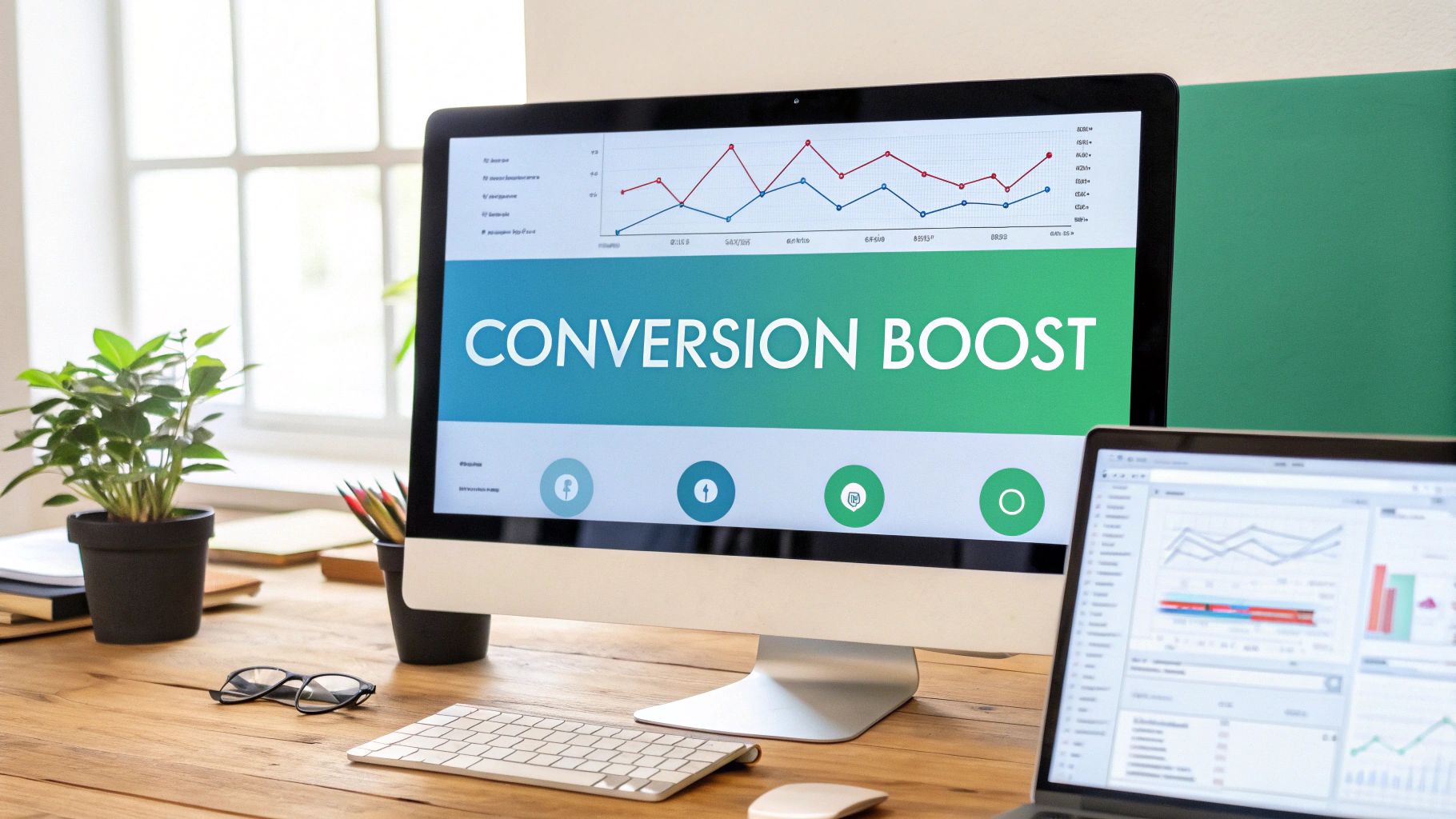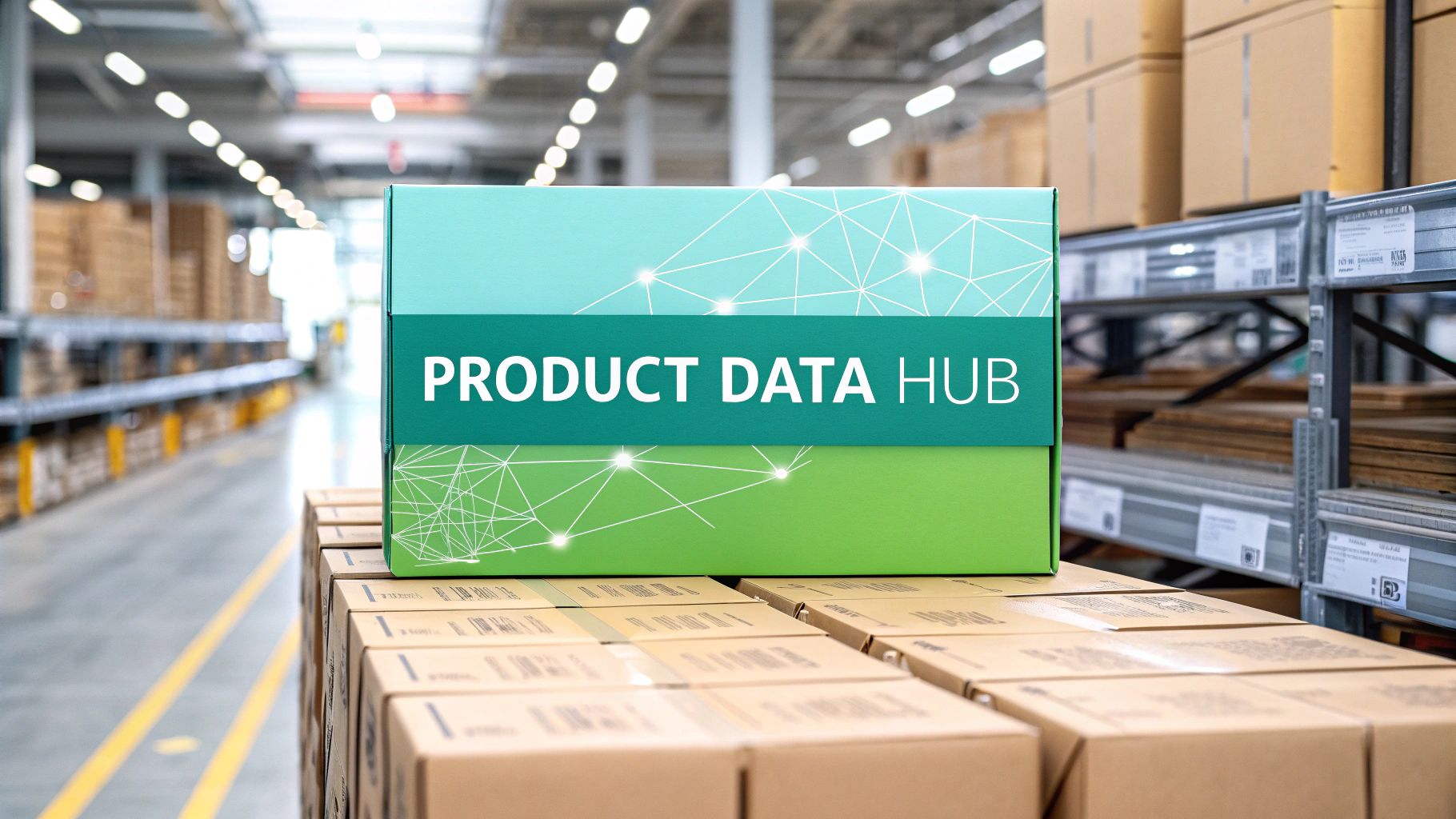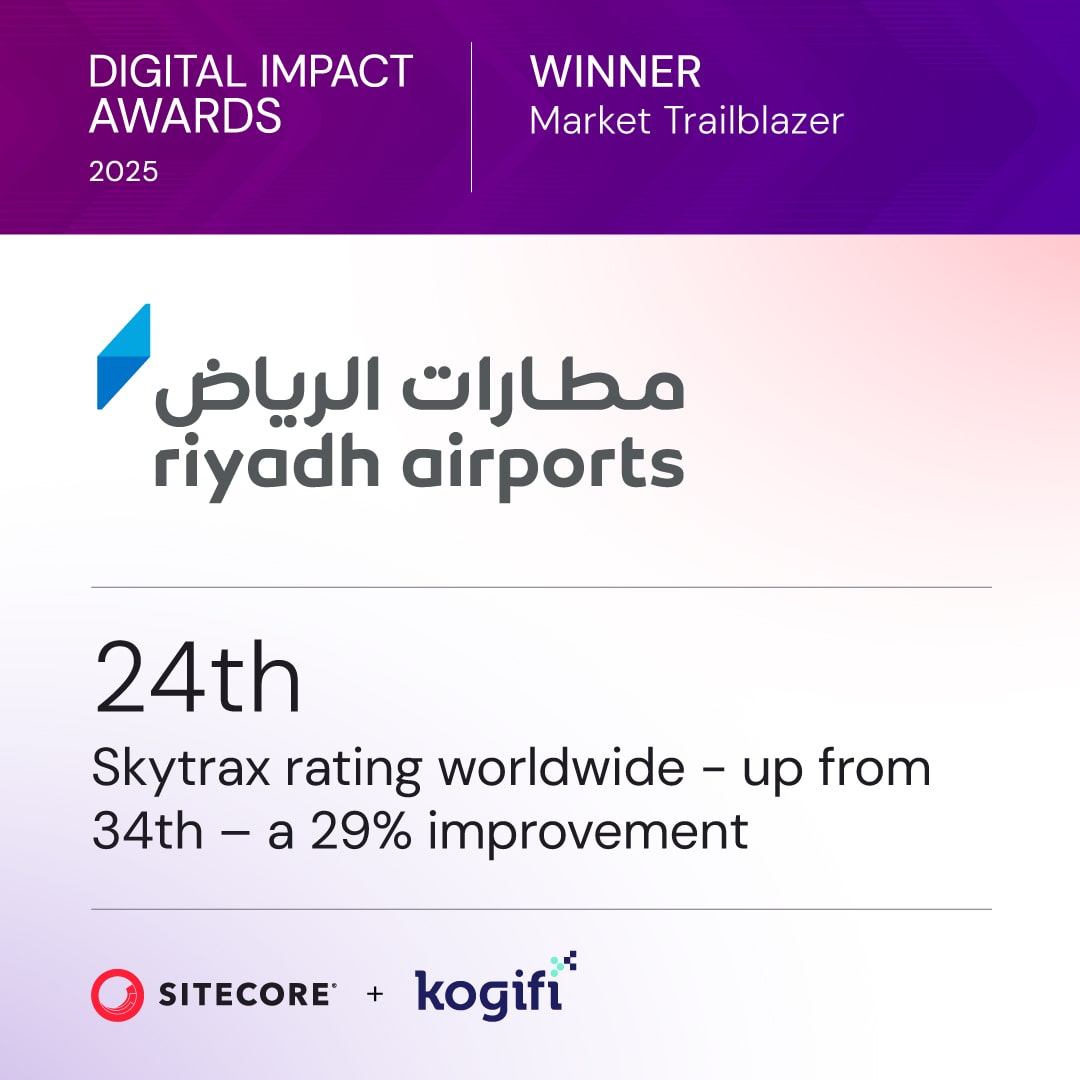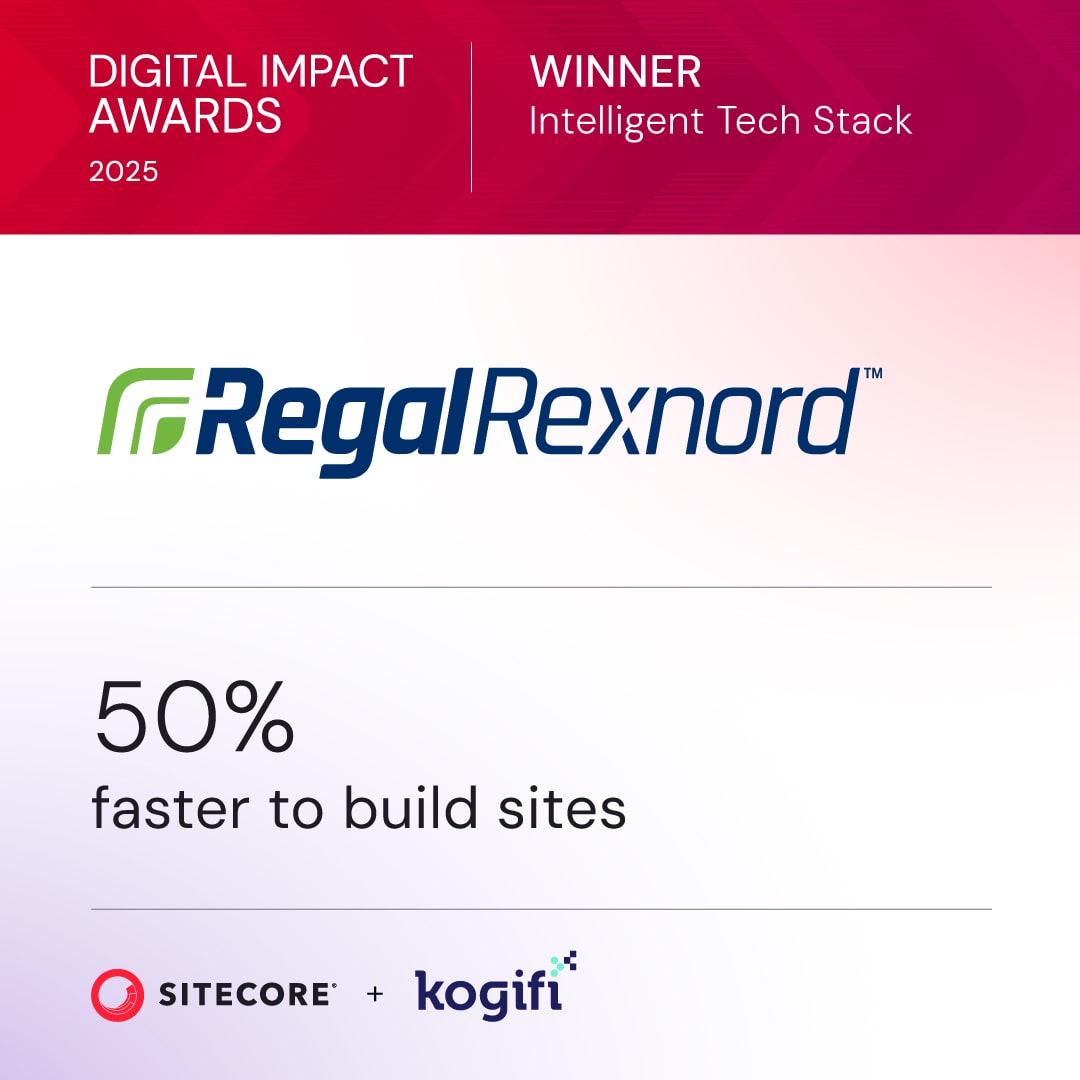Conversion rate optimization is about much more than just tweaking a button color and hoping for the best. It's a systematic methodology for understanding user behavior, forming intelligent hypotheses to improve their experience, and then using data to validate those ideas into tangible business growth. At its core, it's about converting more of the traffic you already have into customers, leads, or subscribers by leveraging the full power of your digital experience platform.
Building Your CRO Framework in Sitecore
Great CRO doesn't start with random A/B tests. It starts with a solid framework—a strategic blueprint that guides every move you make. If you’re already invested in a powerful Digital Experience Platform (DXP) like Sitecore, building this foundation right inside the platform is the smartest move. This approach ensures your efforts are connected to your data, personalization tools, and bigger business goals from the get-go.
This is the stage where you ask the important questions before you even dream of launching a test. It’s the difference between guessing what might work and knowing exactly where your biggest opportunities are hiding within your Sitecore data.
Conduct a Practical Digital Maturity Assessment
Before you start optimizing, you need a clear picture of what you're already capable of. A digital maturity assessment doesn't have to be a month-long ordeal; think of it as a quick, practical audit of your current personalization and data strategies within the Sitecore ecosystem.
Start by looking at how you're actually using Sitecore's features. Are you using basic rules-based personalization in Sitecore XM, or are you still showing every single visitor the exact same thing?
Take a hard look at these key areas:
- Data Collection: Is Sitecore Analytics configured to capture meaningful interactions and goals, or are you just tracking page views?
- Personalization Usage: Are you tinkering with simple component-level personalization, or have you actually mapped out entire user journeys for different segments using Sitecore's marketing automation tools?
- Content Strategy: Is your content properly tagged and structured within the Sitecore content tree so it can be delivered dynamically to different audiences?
This simple assessment will light up the gaps in your strategy. For example, you might find you’re collecting tons of data in xDB but have no real segmentation plan to make it actionable. This audit tells you precisely where to focus your first CRO efforts for the biggest bang for your buck.
Define Business-Aligned KPIs in Sitecore
Metrics like bounce rate or time on page are fine, but they don't tell the full story. To make CRO truly effective, you have to tie your efforts to real business outcomes. Inside Sitecore Analytics, you can go way beyond these surface-level metrics and track what really matters.
Define your key performance indicators (KPIs) around goals that have tangible business value. For instance, instead of just counting "form fills," start tracking the Engagement Value Score of leads from a specific campaign. You can configure this score in Sitecore to assign different point values to various user actions—like downloading a whitepaper, visiting the pricing page, or watching a demo. A visitor who racks up a high score is a much hotter lead, and optimizing for that is far more valuable than just getting more form submissions.
By focusing on Engagement Value, you shift from optimizing for clicks to optimizing for customer lifetime value. This aligns your digital marketing efforts directly with revenue goals, making the impact of your CRO program undeniable to stakeholders.
Audit User Journeys and Conversion Paths
Your website isn't a single entity; it's a series of pathways that users follow. A crucial part of your framework is to map out and audit these journeys. A key question here often revolves around the impact of landing pages on PPC conversion, which really highlights how vital they are in turning visitors into actual customers.
Start by identifying the main conversion paths on your site. This could be the journey from a paid ad to a landing page and finally to a thank you page, or from a blog post to a newsletter signup. Use the path analyzer tools within the Sitecore ecosystem to visualize these paths and pinpoint friction points where users might be dropping off. You can learn more about how a robust Sitecore platform supports this level of detailed analysis.
The goal is to make sure your entire technical setup, whether it's Sitecore XM Cloud or a SharePoint-based portal, is primed for performance and gives users a smooth, seamless path from entry to conversion.
Driving Engagement with Sitecore Personalization
A one-size-fits-all website just doesn’t work anymore. If you're serious about website conversion rate optimization, you have to move past generic content and start delivering experiences that actually resonate with individual visitors. This is where a powerful Digital Experience Platform (DXP) like Sitecore becomes a game-changer, giving you the tools to craft tailored journeys that genuinely connect.
Instead of greeting every visitor with the same old homepage, you can fire up Sitecore's rules engine to serve up dynamic, relevant content. This isn't just about swapping out a banner image; it's about fundamentally rethinking the user journey based on who someone is, where they came from, and what they've done on your site before.

Activating Sitecore’s Rules Engine for Dynamic Content
At the heart of Sitecore's magic is its robust rules engine. This tool lets you set up conditions—or rules—that trigger specific content changes for different user segments. And the best part? You can create these rules based on a massive array of data points that Sitecore collects in real-time.
Think about the possibilities. Here are just a few of the powerful personalization triggers you can use:
- Real-time Behavior: Change content based on the pages a user is looking at right now, the goals they've triggered during their session, or the search terms they just typed into your site's search bar.
- Geolocation: Show a visitor from a specific country or city content that's relevant to them, like local promotions or the nearest brick-and-mortar store.
- Historical Data: Sitecore builds a rich profile of each visitor over time. You can tap into their past visit history, downloaded assets, or previous purchases to personalize their current experience.
- Campaign and Referral Data: Greet visitors arriving from a specific marketing campaign or social media channel with a message that perfectly matches the ad they just clicked.
It's also crucial to know where your conversions are coming from. For instance, direct traffic—when users type your URL right into their browser—consistently has high conversion potential. Knowing this helps you build smarter rules; a direct visitor is likely a returning customer who needs a different experience than a first-timer who clicked a paid ad.
Real-World Personalization Scenarios in Action
Let’s get practical. Imagine an e-commerce company using Sitecore Personalize. When a user keeps browsing hiking boots, the rules engine can automatically tweak the homepage for their next visit. The main banner might now feature a "New Arrivals in Hiking Gear" promo, and product carousels could start prioritizing trail-running shoes and outdoor apparel.
This simple change creates a highly relevant experience that feels intuitive and helpful, dramatically increasing the chance of a sale.
Now, picture a B2B tech firm. Using IP lookup data, Sitecore identifies a visitor from a company in the financial services industry. Instantly, the generic homepage transforms:
- The headline shifts to "Secure Cloud Solutions for Financial Institutions."
- Case studies featuring banking clients are pushed to the forefront.
- The main call-to-action (CTA) now links to a whitepaper on "Cybersecurity Trends in FinTech."
This level of targeting speaks directly to the visitor's pain points and makes your value proposition crystal clear. To learn more about the strategies behind this, you can explore our comprehensive guide on personalization on the web.
The goal isn’t to be clever with personalization; it's to be genuinely useful. When personalization removes friction and helps a user achieve their goal faster, conversions naturally follow. This is the core principle of effective website conversion rate optimization.
Building Rich User Profiles for Continuous Improvement
Personalization in Sitecore isn't a "set it and forget it" tactic. It’s a continuous feedback loop. Every single interaction a user has—every click, download, or purchase—adds another layer of data to their profile within the Sitecore Experience Database (xDB).
This process creates an ever-growing, increasingly accurate picture of each customer. You can leverage this data to build incredibly specific audience segments, moving beyond simple demographics to target users based on their demonstrated interests and behaviors.
For example, you could create a segment of "High-Intent B2B Prospects" who have visited your pricing page more than twice, downloaded a specific case study, and work for a company with over 500 employees. This segment can then be served a hyper-personalized experience, maybe even one that triggers a real-time notification to your sales team.
By building these rich profiles, you create a powerful cycle: deeper insights fuel better personalization, which drives more engagement and captures even richer data. It's this ongoing process that turns a good website into a high-performing conversion engine.
Using Data to Optimize with A/B Testing
Relying on guesswork for your website's conversion rate is like navigating without a map. To get anywhere meaningful, every decision you make has to be backed by data. The single best way to validate your ideas is through rigorous testing, and the Sitecore ecosystem has powerful tools built right in for this purpose.
This isn't about throwing random changes at the wall to see what sticks. It's a structured process: identify a problem, form an educated guess about how to fix it, and then let your users' behavior tell you if you were right. When you shift from assumptions to evidence, your website stops being a static brochure and starts becoming a dynamic asset that constantly improves.
This flow chart nails the fundamental cycle of data-driven optimization.
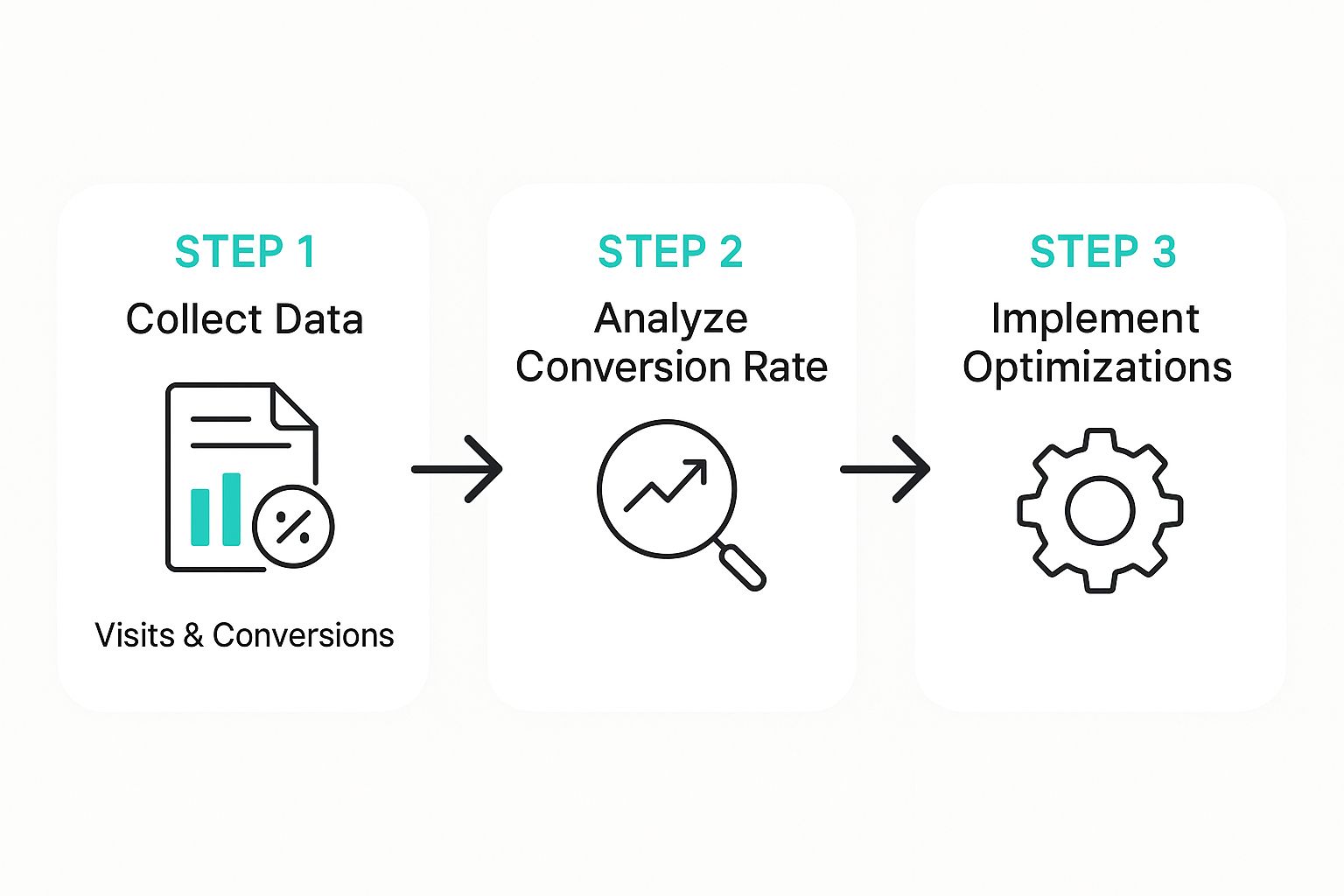
It’s a simple but powerful loop: data collection informs your analysis, which then guides what you choose to optimize next.
Crafting a Strong Hypothesis in Sitecore
Before you even think about launching a test, you need a solid hypothesis—a clear, testable statement about what you expect to happen. Vague ideas like "a new hero image will be better" just won't cut it. A real hypothesis grows out of insights you've pulled from Sitecore Analytics and customer feedback.
For instance, you might be digging into user paths in Sitecore and notice a huge drop-off rate on your main product category page. That observation is your starting point. From there, you could form a hypothesis like this: "By replacing the static product grid with a personalized component that shows recently viewed items, we believe we can reduce the exit rate by 15% and increase 'add to cart' clicks, because the content will be more relevant to returning users."
See the difference? It's specific, measurable, and gives a clear reason why you think it will work. That’s the kind of foundation you need for a successful test.
Choosing Between A/B and Multivariate Testing
Sitecore gives you two main testing flavors: A/B testing and multivariate testing (MVT). Knowing which one to use is crucial for efficient conversion rate optimization.
A/B Testing is your go-to for testing big, singular changes. You’re comparing two completely different versions of a page (Version A vs. Version B) to see which one performs better. It's perfect when you have a major redesign idea for a landing page or want to pit two very different value propositions against each other in a headline.
Multivariate Testing (MVT) is for refining pages by testing several smaller changes at the same time. Think of a checkout page where you want to test three different headlines, two button colors, and two versions of a security badge all at once. MVT will tell you which combination of those elements performs best, making it a great choice for high-traffic pages where small tweaks can have a massive impact.
To make the choice clearer, here’s a quick comparison of how they stack up within the Sitecore environment.
Sitecore Testing Methods Compared
Essentially, your choice comes down to the question you're trying to answer. A/B testing tells you, "Which page design is better?" while MVT answers, "Which combination of these specific elements is the most effective?"
Setting Up and Interpreting Tests
Getting a test running in Sitecore is pretty straightforward. You can pick a page, create different versions of its components, set your conversion goals (like a form submission or a specific link click), and decide how to split the traffic. One common use case is testing different calls-to-action in email campaigns using Sitecore's marketing automation features.
Once your test has run long enough to hit statistical significance—which just means the results are very likely not due to random chance—it’s time to look at the numbers. Sitecore’s reports will clearly show you which version drove the highest conversion rate. The real key, though, is to not just roll out the winner but to understand why it won. Did the new headline bring more clarity? Did the simpler form reduce friction? Those insights are gold—they'll fuel your next round of hypotheses.
Testing in SharePoint Environments
Now, while SharePoint doesn't come with the same built-in testing tools as a DXP like Sitecore, you can absolutely still build a data-first culture. The method is identical: gather data, form a hypothesis, and test. The only real difference is in the execution, which usually means bringing in a third-party tool.
Platforms can be integrated with SharePoint to run A/B and multivariate tests on your pages, web parts, and user journeys. This lets you apply the exact same rigorous CRO principles to your internal portals or public-facing SharePoint sites, making sure you’re optimizing every digital touchpoint you have. To learn more about modern approaches, this AI-powered A/B testing guide is a great resource.
Optimizing Site Speed for Higher Conversions
When it comes to boosting website conversions, speed isn't just a nice-to-have—it's everything. A slow, clunky website is one of the surest ways to lose a potential customer before they even see what you have to offer. Every millisecond really does count, directly impacting your bounce rates, user satisfaction, and, ultimately, your bottom line.
This is especially true on mobile, where patience wears thin fast. A delay of just a few seconds can be the difference between a sale and a lost opportunity. The data is stark: a slight increase in page load time can cause a significant jump in bounce rate. For more detailed statistics on the impact of load times, you can explore these conversion rate optimization best practices.

Modern Architectures Built for Speed
The good news is that modern platforms like Sitecore's composable DXP and XM Cloud are engineered from the ground up for performance. They run on a headless architecture, which essentially separates the back-end content management from the front-end user experience. This decoupling gives your developers the freedom to build incredibly fast and responsive interfaces using the latest JavaScript frameworks like Next.js or Angular.
On top of that, Sitecore XM Cloud gives you an immediate speed boost with its global Content Delivery Network (CDN). When someone visits your site, the content is served from a server that's geographically closest to them, which dramatically slashes latency. This isn't just a minor tweak; it's a fundamental architectural shift that gives you a high-performance baseline right out of the box.
A Practical Checklist for Existing Platforms
But what if you're already on an existing Sitecore or SharePoint instance? Don't worry, there are still plenty of powerful techniques you can use to squeeze more speed out of your site. Think of this as your go-to checklist for diagnosing and fixing the most common performance bottlenecks.
Key Optimization Techniques:
- Aggressive Image Compression: Unoptimized images are almost always the biggest culprits behind slow load times. Switch to modern formats like WebP and use tools that automatically compress images when they're uploaded, all without any noticeable drop in quality.
- Code Minification: This is the process of stripping out unnecessary characters—like spaces and comments—from your HTML, CSS, and JavaScript files. Smaller files download faster, which means the browser can render your page much quicker.
- Advanced Caching Strategies: You need to configure caching at multiple levels. Use Sitecore’s built-in HTML caching for individual components and add external layers like Varnish or Redis to serve up static content without having to ping your server every single time. For SharePoint users, properly configuring the BlobCache can make a huge difference in how quickly large files are delivered.
Your goal is simple: make the browser do as little work as possible. Every cached asset and every compressed byte gets the user that much closer to a seamless experience, and that's the clearest path to higher conversions.
Diagnosing Bottlenecks and Understanding Core Web Vitals
You can't fix what you can't measure. Diagnostic tools are absolutely essential for pinpointing exactly where your performance issues are coming from. Google's PageSpeed Insights and Lighthouse are fantastic places to start. They'll analyze your site and give you a list of actionable recommendations.
These tools also grade your site on Core Web Vitals, a set of specific metrics Google uses to judge user experience:
- Largest Contentful Paint (LCP): This measures how long it takes for the main content of your page to load. You want to aim for an LCP of 2.5 seconds or less.
- First Input Delay (FID): This measures how responsive your site is to user interaction. A good FID is 100 milliseconds or less.
- Cumulative Layout Shift (CLS): This measures visual stability—think of annoying elements that jump around as the page loads. Your goal here is a CLS score of 0.1 or less.
Improving these scores isn't just an SEO exercise; it's directly tied to a better user experience, which in turn leads to higher conversion rates. For a deeper dive into these and other performance-tuning methods, check out our guide on how to optimize website performance. By methodically tackling each bottleneck, you can ensure your website is not just fast, but also incredibly effective at turning visitors into loyal customers.
Bring All Your Customer Data Together with Sitecore CDP
If you want to really move the needle on your website's conversion rates, you have to stop thinking in terms of isolated A/B tests. The real wins come from a deep, unified understanding of your customer. This is exactly where a Customer Data Platform (CDP) comes in, transforming your strategy from making reactive tweaks to building a smart, continuous optimization engine.
Think of Sitecore CDP as the central nervous system for all your customer data.
Its primary job is to tear down the data silos that keep you from seeing the complete customer journey. It pulls information from your website, CRM, mobile app, and even offline sources like in-store purchases, funneling it all into a single, comprehensive profile for each customer. Without this 360-degree view, you’re just optimizing for a tiny piece of their experience.
This is what it looks like in practice—a unified profile that combines identity, channel activity, and order history into one clear dashboard.

What you're seeing here isn't just a collection of data; it's a single source of truth. It gives marketers the power to understand customer behavior across every touchpoint, not just what happens on the website. This clarity is the bedrock for creating experiences that are genuinely meaningful and drive conversions.
Create Smarter Segments with a Unified View
Once all your data is in one place, the real fun begins. Sitecore CDP lets you go way beyond basic demographic segments and start building audiences based on what people actually do. You no longer have to guess who your most valuable customers are—the data will tell you.
For example, you can create dynamic segments like:
- "High-Intent Shoppers": Users who visited a specific product page three times in the last week but still haven't bought anything.
- "Churn Risks": Customers who were once frequent buyers but haven't made a purchase or logged in for the last 90 days.
- "Cross-Sell Opportunities": Clients who bought Product A and have recently been looking at support articles for Product B.
These segments aren't static. People move in and out of them in real-time based on their actions, which means you can trigger automated, highly relevant campaigns with surgical precision.
Drive Next-Level Personalization and Campaigns
Armed with these rich profiles, you can finally deliver personalization that feels helpful, not creepy. For that "High-Intent Shopper," you could use Sitecore Personalize to pop a free shipping banner the next time they visit. For a customer flagged as a "Churn Risk," you could automatically send an email with a special "we miss you" discount.
This is a world away from just changing a homepage banner. It's about orchestrating a connected experience across every channel—web, email, mobile, and even in-person. The unified profile ensures your message is consistent and relevant no matter where the customer shows up.
By connecting all your data points in Sitecore CDP, you stop treating each interaction as a separate event. Instead, you see them as connected parts of a larger conversation, allowing you to respond with the right message at the perfect moment.
Find Conversion Opportunities You Never Knew Existed
When you feed Sitecore's analytics tools with the rich, consolidated data from its CDP, their power multiplies. You can analyze the entire end-to-end customer journey and pinpoint friction points that were invisible before.
You might discover that customers who use your live chat support are 50% more likely to convert on their next visit. Now that is a goldmine of an insight.
It tells you that investing in chat support isn't just a customer service expense; it's a direct driver of revenue. With that knowledge, you can start testing ways to make the chat feature more prominent for users who are showing strong buying signals. These are the kinds of game-changing opportunities that only a unified view of your data can uncover.
While SharePoint doesn't have a native CDP, the principle is just as crucial for organizations using it for intranets or public sites. The strategy involves integrating SharePoint with a central data warehouse or a third-party CDP to combine interaction data with information from other business systems. The goal is the same: create a single source of truth to drive smarter decisions and better experiences.
Common Questions About CRO
When you're digging into conversion rate optimization, questions are going to pop up. It's just part of the process. This is especially true when you're working with powerful platforms like Sitecore. Let’s tackle some of the most common ones I hear from marketers and dev teams.
One of the first things people ask is, "What's a good conversion rate?" The honest answer? It varies wildly. The real key is to stop worrying about industry benchmarks and start focusing on your own continuous improvement. A good conversion rate is one that’s consistently better than it was last quarter, all thanks to smart, data-backed tweaks.
What Is the Role of a DXP in CRO?
A Digital Experience Platform (DXP) like Sitecore really changes the game for CRO. You move way beyond simple landing page tests and start thinking about the entire customer journey. Instead of just tweaking a button color, a DXP lets you optimize whole sequences of experiences using unified customer data.
Think about it this way. With a DXP, you can:
- Connect online and offline data to personalize a web experience based on what a customer bought in your physical store.
- Automate journey adjustments in real time, gently guiding users toward your conversion goals based on their behavior right now.
- Run consistent tests across every touchpoint, from your website to your mobile app and beyond.
This holistic approach makes every optimization far more impactful. For a deeper dive into these kinds of strategies, check out this expert guide on improving website conversion rates.
How Can SharePoint Users Approach CRO?
Just because you’re on SharePoint doesn't mean you're left out of CRO. Far from it. While SharePoint isn't a DXP, the core principles of optimization stay the same—you just use a different set of tools. Typically, SharePoint users will integrate third-party analytics and testing tools to gather data and run experiments on their sites and intranets.
In a SharePoint environment, the focus often shifts to things like:
- Content and Document Accessibility: Making sure people can find information quickly is a huge win. It cuts down on friction and keeps users happy.
- Form and Workflow Optimization: Streamlining internal processes or customer-facing forms on an intranet is absolutely a form of conversion optimization.
- User Experience Enhancements: Using web parts and custom development to improve navigation and usability can have a massive impact.
The heart of great CRO isn’t about which platform you use. It's about having a disciplined process: hypothesize, test, and learn from the results. The platform is just the tool that helps you execute that process at scale.
Whether you're using Sitecore's all-in-one suite or pairing SharePoint with other tools, the goal is always the same: use data to build better experiences that encourage people to take action.
At Kogifi, we specialize in turning digital platforms into high-performing conversion engines. Contact us today to see how our Sitecore and SharePoint expertise can level up your CRO strategy.

















